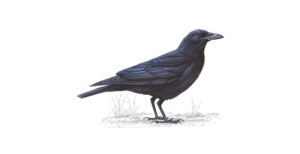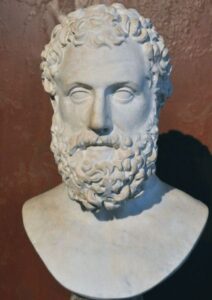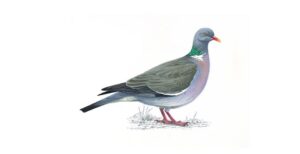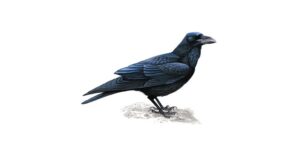
Carrion crow – picture RSPB
Biologists have long known the corvid family – it includes crows, ravens, rooks, magpies and jackdaws – to be among the smartest of all birds. Corvids, and other birds, have been seen to solve problems by insight and learn by example, as human children do. On the Pacific island of New Caledonia, crows have demonstrated a tool-making, and tool using, capability comparable to Palaeolithic man’s.
So last week’s story (Feb, 2022) in the Guardian is just another example of avian intelligence. In summary a company in a Danish town has managed to train crows to deposit cigarette butts in an adapted bin. The bin rewards the bird with a piece of food for each butt. Using birds to clean up a pernicious piece of litter could save the town a lot of money. The story.
Below I post a piece of mine on bird intelligence. “Birds Brains” is one of a series of essays I wrote on the David Attenborough series Life of Birds for PBS, the US Public Broadcasting Service. PBS put up the essay on its website in 1997, and it is still available there.
*********
The scene: a traffic light crossing on a university campus in Japan. Carrion crows and humans line up patiently, waiting for the traffic to halt.
When the lights change, the birds hop in front of the cars and place walnuts, which they picked from the adjoining trees, on the road. After the lights turn green again, the birds fly away and vehicles drive over the nuts, cracking them open. Finally, when it’s time to cross again, the crows join the pedestrians and pick up their meal.
If the cars miss the nuts, the birds sometimes hop back and put them somewhere else on the road. Or they sit on electricity wires and drop them in front of vehicles.
Biologists already knew the corvid family – it includes crows, ravens, rooks, magpies and jackdaws – to be among the smartest of all birds. But this remarkable piece of behaviour – it features in the final programme of “Life of Birds” – would seem to be a particularly acute demonstration of bird intelligence.
The crows in Japan have only been cracking nuts this way since about 1990. They have since been seen doing it in California. Researchers believe they probably noticed cars driving over nuts fallen from a walnut tree overhanging a road. The crows already knew about dropping clams from a height on the seashore to break them open, but found this did not work for walnuts because of their soft green outer shell.
Other birds do this, although not with quite the same precision. In the Dardia Mountains of Greece, eagles can be seen carrying tortoises up to a great height and dropping them on to rocks below. The hapless Aeschylus (525-456 BC), a father of Greek tragic drama, is said to have met his end by this means.
A seer predicted he would die when a house fell on him, so the wary scribe departed for the hillsides, well away from any dwellings, where he believed he was safe. He wasn’t. An eagle is said to have mistaken Aeschylus’ bald pate for a stone, and dropped the creature in its “house” onto it.

Aeschylus – photo Berlin, Neues Museum
Scientists have argued for decades over whether wild creatures, including birds, show genuine intelligence. Some still consider the human mind to be unique, with animals capable of only the simplest mental processes. But a new generation of scientists believe that creatures, including birds, can solve problems by insight and even learn by example, as human children do. Birds can even talk in a meaningful way.
Some birds show quite astonishing powers of recall. The Clarke’s nutcracker, a type of North American crow, may have the animal world’s keenest memory. It collects up to 30,000 pine seeds over three weeks in November, then carefully buries them for safe keeping across over an area of 200 square miles. Over the next eight months, it succeeds in retrieving over 90 percent of them, even when they are covered in feet of snow
On the Pacific island of New Caledonia, the crows demonstrate a tool-making, and tool using, capability comparable to Palaeolithic man’s. Dr Gavin Hunt, a New Zealand biologist, spent three years observing the birds. He found that they used two different forms of hooked “tool” to pull grubs from deep within tree trunks.
Other birds and some primates have been seen to use objects to forage. But what is unusual here is that the crows also make their own tools. Using their beaks as scissors and snippers, they fashion hooks from twigs, and make barbed, serrated rakes or combs from stiff leathery leaves. And they don’t throw the tools away after one use–they carry them from one foraging place to another.
Scientists are still debating what this behaviour – shown in programme three – means. Man’s use of tools is considered a prime indication of his intelligence. Is this a skill acquired by chance? Did the crows acquire tool making skills by trial and error rather than planning? Or, in its ability to adapt and exploit an enormous range of resources and habitats, is the crow closer to humans than any other creature?
Dr Hunt, then of Massey University in New Zealand, said this of his research: “There are many intriguing questions that remain to be answered about crows’ tool behaviour. Most important would be whether or not they mostly learn or genetically inherit the know-how to make and use tools. Without knowing that it is difficult to say anything about their intelligence, although one could guess that these crows have the capability to be as clever as crows in general.”
The woodpecker finch, a bird of the Galapagos, is another consummate toolmaker. It will snap off a twig, trim it to size and use it to pry insects out of bark. In captivity, a cactus finch learnt how to do this by watching the woodpecker finch from its cage. The teacher helped the pupil by passing a ready-made spine across for the cactus finch to use.
Sometimes a bird species’ very survival depends on its ability to learn fast. Birds need to recognize a cuckoo egg dumped in their own nest and either throw out the strange egg or desert the nest to start afresh. In Japan, the common cuckoo recently switched to a new, unsuspecting host on which to dump its eggs, the azure-winged magpie. The emerging cuckoo chicks ejected their foster siblings, and the magpie population dropped dramatically.
Ten years on, the magpies started to fight back. They learnt to detect the “foreign” eggs. Within a few years, there was a four-fold increase in its rejection of cuckoo eggs. The speed with which the magpie changed its behavior has astounded biologists.
Another sign of intelligence, thought to be absent in most non-human animals, is the ability to engage in complex, meaningful communication. The work of Professor Irene Pepperberg of the University of Arizona, Tucson, has now shown the general perception of parrots as mindless mimics to be incorrect.
The captive African grey parrot Alex is one of a number of parrots and macaws now believed to have the intelligence and emotional make-up of a 3 to 4 year old child. Under the tutelage of Professor Pepperberg, he acquired a vocabulary of over 100 words. He could say the words for colors and shapes and, apparently, use them meaningfully. He has learned the labels for more than 35 different objects; he knows when to use “no,” and phrases such as “come here”, “I want X,” and “Wanna go Y.”
A bird’s ability to understand, or speak, another bird’s language can be very valuable. New Zealand saddlebacks, starling-like birds, occupy the same territory for years. They have distinct song “dialects” passed on through the generations.
New territory vacancies are hard to find, so young males are always on the look-out for new widows into whose territory they can move. While they wander around the forest, they learn the different dialect songs, just as we might learn a language or develop a regional dialect.
As soon as a territory-owning male dies, a new young male may move in to take over within 10 minutes. He will immediately start singing the dialect of the territory he is in.

Wood pigeon – picture RSPB
Intelligence – if this is what scientists agree these birds possess–is not limited to the birds we always thought of as “bright.” In recent experiments at Cardiff University in Britain, a pigeon identified subtle differences between abstract designs that even art students did not notice. It could even tell that a Picasso was not the same as a Monet. The experiment seems to show that pigeons can hold concepts, or ideas, in their heads. The visual concept for the pigeon is Picasso’s painting style.
Some birds seem to indulge in “intelligent” play. The kea, a New Zealand parrot, has been filmed ripping (inedible) windscreen wipers off cars. Young keas, in a neat variation of ringing the doorbell and running away, are known to drop rocks on roofs to make people run outside.
Jack the jackdaw was raised by wildlife film producer John Downer. As soon as Jack was mature, he was released into the wild. However, he couldn’t stay away. “One thing he is totally fascinated by is telephones,” said Downer. “He knows how to hit the loudspeaker button and preset dial button. Once we came into the office to find him squawking down the telephone to the local travel agent.”
Jack also likes to fly down onto the mirror of the production car when he sees somebody going out. “He turns into the wind, gets his head down and surfs on the air current until we reach about 30 mph when he gives up.
“Like all jackdaws, Jack shows great versatility and intelligence. Because he has to exploit a wide range of foods, he is investigating things all the time.”
However, scientists believe it is not physical need that drives creatures to become smarter, but social necessity. The complexities of living together require a higher level of intelligence. Corvids and parrots, along with dolphins, chimps, and humans are all highly social–and smart–animals.
Some ravens certainly apply their intelligence for the good of the flock. In North America, they contact other ravens to tell them the location of a carcass. Ravens are specialized feeders on the carcasses of large mammals such as moose during the harsh winter months of North America. The birds roost together at night on a tree, arriving noisily from all directions shortly before sunset. The next morning, all the birds leave the roost as highly synchronized groups at dawn, giving a few noisy caws, followed by honking.
They may all be flying off in the direction taken by a bird, which had discovered a carcass the previous day. This bird leads the others to his food store, apparently sharing his prize finding with the rest of the flock.

Raven – picture RSPB
Ravens share information about their findings of food carcasses because dead animals are patchily distributed and hard to find. Many eyes have a better chance of finding a carcass, and once one has been located, the information is pooled.
Although the carcass now has to be shared between more individuals, the heavy snowfall and risk of mammal scavengers taking the kill mean that a single bird or a small group could not eat it all alone anyway. Some are even believed to solicit help with the carving, by tipping off other predators, such as wolves, about the meat so they will rip it open and make it more accessible to the ravens.
The African honeyguide lures badgers to bees nests, and feeds on the leftovers. To humans they offer their services as paid employees. They call and fly backwards and forward to draw local tribespeoples’ attention to the location of honeycombs, and are then rewarded with a share of the takings for their trouble.
Of course, the bird world has its share of “bird brains.” There are the birds that build three nests behind three holes under a flower pot, because they can’t remember which is which, and birds that attack their own reflections. The Hawaiian goose is as innocent of danger as a baby crawling along the girder in an unfinished skyscraper. It would walk up to an introduced mongoose on Hawaii, and be attacked.
The level of intelligence among birds may vary. But no living bird is truly stupid. Each generation of birds that leaves the protection of its parents to become independent has the inborn genetic information that will help it to survive in the outside world and the skills that it has learned from its parents.
They would never have met the challenge of evolution without some degree of native cunning. It’s just that some have much more than others.
The original article on the PBS site
A link to the whole list of essays.
